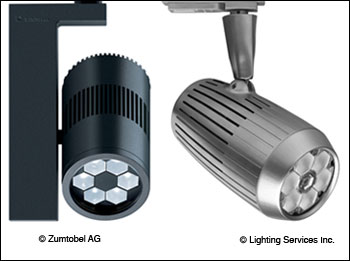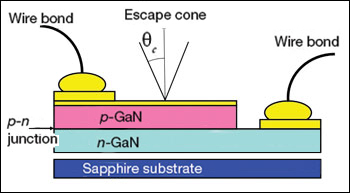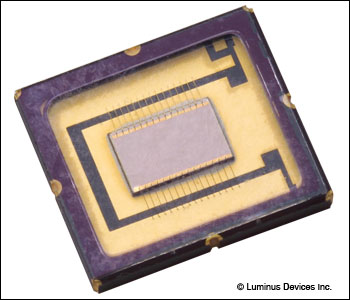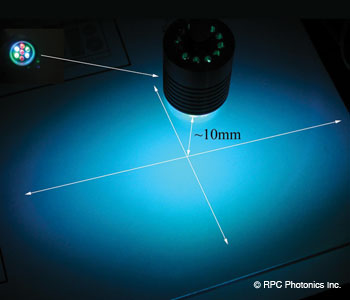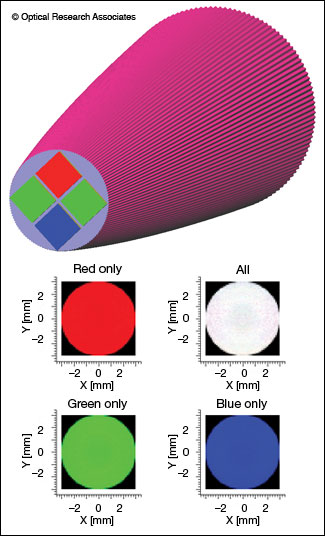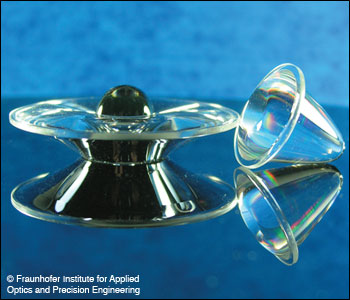
Molded acrylic optical components using refraction and total internal reflection can function as non-imaging collection optics with LEDs.
If you hear the term “solid-state lighting,” you will most likely think of light-emitting diodes (LEDs). Like other light sources, these semiconductor devices convert electrical energy into visible light. From their humble beginnings in the 1960s as red indicator lamps, LEDs are now competitive with incandescent and compact fluorescent lights in terms of their energy efficiency. As their performance continues to improve, solid-state lighting is expected to supplant incandescent and fluorescent lamps in providing “white light” illumination for homes and offices. It will also provide energy-efficient backlighting for LCD televisions and computer displays.
Light-emitting diodes
The key component of solid-state lighting is, of course, the LED. These devices exhibit spontaneous light emission (or electroluminescence) when electrical current flows across the junction of p-doped and n-doped semiconductor materials. This process can be extremely efficient, with internal quantum efficiencies close to unity in some cases.
The spectral power distribution of an LED is determined by the bandgap energy of its semiconductor material, which can be tailored through alloy composition to span the spectrum from ultraviolet through infrared. Commercial high-flux LEDs suitable for solid-state lighting are based on aluminum-indium-gallium nitride (AlInGaN) alloys for blue and green emissions (roughly 440 to 550 nm), and aluminum-indium-gallium phosphide (AlInGaP) alloys for amber (585 to 595 nm) and red (615 to 645 nm) emissions. The internal quantum efficiencies of these materials are roughly 50 percent for AlInGaN and close to 100 percent for AlInGaP.
|
Examples of solid-state lighting fixtures: Tempura track light (left) and LumeLEX track light (right).
Typical AlInGaN light-emitting diode construction. |
From an optics perspective, the most interesting feature of these alloys is their high refractive indices: ns ≈ 2.5 for AlInGaN and ns ≈ 3.4 for AlInGaP. When they are encapsulated in transparent media such as epoxy or silicone with a refractive index of ne , the photons generated within the p-n junction can exit the semiconductor only if their angle of incidence is less than the critical angle given by Snell’s law: θc = sin–1(ne /ns ). Photons with incidence angles outside of this escape cone undergo total internal reflection, and are typically absorbed by the substrate or electrodes—which results in heat generation. This can lead to external quantum efficiencies (EQEs) of only a few percent.
There are several approaches to overcoming this problem. One of the most obvious is to use an encapsulant with a high refractive index. However, while there are optically clear polymers with ns ≈ 1.7 available, they need to withstand intense actinic radiation from blue LEDs, transient thermal gradients as high as 3000° C/cm, and temperatures in excess of 200° C. These hostile conditions usually require high-flux LEDs to be encapsulated in a soft silicone gel with a hard acrylic or silicone dome lens.
A more useful approach is to roughen the semiconductor surface with a chemical etchant. This scatters the incident photons and so increases their probability of escape, resulting in radiant power increases of two to three times. (This is similar in principle to moth-eye antireflection coatings with their graded refractive indices.) In a variation of this technique, engineers at OSRAM Opto Semiconductors etch a pattern of hexagonal cones into the AlInGaN surface, then apply a reflective metallic coating before removing the semiconductor film from the substrate and bonding it upside down on another substrate. The metallized film acts as a mirror to redirect photons towards the top surface, with a 70 percent increase in EQE for their commercial OSTAR LEDs.
Another approach is to etch a periodic 2D pattern into the semiconductor surface. This can be done using e-beam lithography, but holographic photolithography is better suited for mass production. Recent work has demonstrated that the LED power can be more than doubled with such techniques.
A closely related approach involves periodic 2D arrays of holes that are spaced on the order of a wavelength of visible light (400 to 700 nm). These photonic lattices can be generated by patterning the substrate or the top surface of the LED die, again using e-beam or photolithography. These lattices can also be fabricated separately and bonded to the die surface. In addition to doubling the device EQE, the emitted light is partially collimated towards the surface normal.
This property has been successfully exploited by Luminus Devices with their PhlatLight LEDs for projection systems and LCD television panel backlighting. Compared with conventional LEDs that exhibit essentially Lambertian luminous intensity distributions, photonic lattice LEDs feature higher luminances (as much as ten times improvement) and require collection optics with smaller numerical apertures.
There are other approaches to increasing light extraction from LED dies, ranging from shaped chips and distributed Bragg reflectors to surface plasmon and microcavity LEDs. These, however, are dependent on LED fabrication techniques, and offer fewer opportunities for innovative optical design solutions.
|
High-flux photonic lattice LEDs offer partially collimated emissions and high surface luminance for LCD television and projector applications. |
Phosphors
White light LEDs, such as those used for cell phone display backlighting and in LED flashlights, consist of a blue AlInGaN LED with a yttrium-aluminum-garnet (YAG) phosphor doped with cerium ions. The LED optically pumps the phosphor, which emits yellowish light. The combination of yellow and blue light appears as “cool” white light to the human eye, with color temperatures ranging from roughly 5000 to 8000 K. Proprietary red-emitting phosphors may be added to produce “warm” white LEDs with color temperatures in the range of 2800 to 3500 K. (The equivalent fluorescent lamp colors are labeled “daylight” and “warm white,” respectively.)
At present, the phosphors are either mixed into the LED encapsulant or conformally coated onto the LED die. This can be problematic for high-flux LEDs, where power levels can exceed 100 W/cm2, and radiant heating can cause phosphor particle temperatures to exceed 250° C. YAG phosphors at this temperature exhibit a 40 percent decrease in efficiency from operation at 100° C, which leads to both lower LED power output and color shifts due to changes in the ratio of yellow to blue light.
Phosphor development for LEDs is an active field, especially the development of quantum dot phosphors with tunable spectral power distributions. Surprisingly, little research has been done on incorporating phosphors into optical components rather than applying them directly to the LEDs.
One such approach is to incorporate the phosphors in a remotely mounted matrix. Without the extreme temperature concerns, this matrix can be a standard optical epoxy. In addition to providing more opportunities for optical design, this configuration can increase the light extraction efficiency by 75 percent or more.
Another approach is to irradiate a phosphor layer applied to a reflective base. While the resultant device may not be as compact as a conventional phosphor-coated LED, improvements in light extraction efficiency of 150 percent have been reported.
Collection optics
LEDs have often been described as point light sources, but this is mostly a matter of scale. While they are much smaller than most incandescent, fluorescent and high-intensity discharge lamps, high-flux LEDS still have luminous areas of 1 mm2 or more. With the trend toward ever smaller LED-based projectors and small architectural lighting fixtures, even this small a luminous area complicates the design of efficient collection optics.
The situation is further complicated by the typically non-uniform luminance distribution of most high-flux LEDs, which have electrodes with complex configurations designed to distribute the current flow through the p-n junction as evenly as possible, and gold wire bonds that may obstruct the LED emissions. Rather than model these physical characteristics, it is possible to measure the four-dimensional near-field luminance distribution with an imaging goniophotometer. One example is the Radiant Imaging SIG-300, whose output is a photometrically calibrated rayset that can be used with most optical design software.
|
A deterministic diffuser can thoroughly mix light from red, green, and blue LEDs to produce a batwing-shaped luminous intensity distribution. |
While designing non-imaging collection optics for high-flux LEDs can be difficult, it is an interesting challenge. For example, the small source size makes it practical to use ultraviolet-curable micro-optics for both LEDs and LED arrays. These optical devices are particularly useful in that they can be mass-produced at low cost and incorporated into the LED packages. Various mastering techniques, including direct laser beam writing, gray-scale photolithography, photoresist reflow and single-point diamond turning, allow the designer to use refractive or diffractive elements as required. Examples of such products for consumer devices are being manufactured by Heptagon, but micro-optics for solid-state lighting are in the pipeline.
Architectural applications of solid-state lighting require a range of luminous intensity distributions, from narrowly focused spots to broad washes of light. Some applications, such as indirect lighting of office ceilings, require so-called “batwing” distributions that provide even illumination despite the cosine falloff typical of linear sources. Other applications, such as cove lighting and wall washing, require distributions that are narrow in one direction but broad in the other. These are reasonably easy to achieve with linear fluorescent lamps, but much more difficult with a linear array of point sources.
There are two approaches to this problem. RPC Photonics has developed deterministic diffusers based on microlens arrays that can provide tailored intensity distributions from individual LEDs and LED arrays, including off-axis distributions that are difficult to achieve with conventional optics. Using direct laser beam writing for the masters, these arrays can be mass-produced using injection-molded plastics. Batwing distributions with excellent color mixing from red, green and blue LED arrays can be achieved over very short distances.
The second approach uses holographic diffusers such as those manufactured by Physical Optics Corporation. While these UV-cured embossed plastic diffusers offer fewer opportunities for tailored intensity distributions, they are still well-suited for linear LED arrays. In particular, they can produce batwing intensity distributions that are ideally suited for indirect lighting applications.
For applications requiring more precise control, such as projection systems, the Fraunhofer Institute for Applied Optics and Precision Engineering has prototyped injection-molded PMMA optical components that produce intensity distributions from LEDs with good beam homogenization, sharp cutoff characteristics and excellent flux utilization.
|
A non-rotationally symmetric tapered mixing rod can thoroughly mix light from red, green and blue LEDs. |
White light
In addition to using phosphor-coated blue LEDs, white light can be generated by blending the emissions of red, green and blue LEDs. This approach has several advantages in that temperature and age-related color shifts can be eliminated, and the user can specify the desired color temperature—something that has never before been possible in architectural lighting without the use of energy-inefficient color filter wheels.
Unfortunately, thoroughly mixing the light from an array of colored LEDs can be exceedingly difficult. The conventional approach has been to use light pipes, but these typically require unreasonably long lengths to provide sufficient mixing. This problem has recently been addressed by Optical Research Associates with a novel light pipe design that is both conveniently short (about 18 mm) and easy to manufacture.
Photometry and colorimetry
The quasimonochromatic emissions of LED sources—and this includes phosphor-coated blue LEDs because of the narrow peak in the blue region of the spectrum—have led to considerable difficulties in obtaining accurate measurements using photometers with spectral responsivities that emulate human vision. Lab-quality spectroradiometers are often required for precise measurements of LED and LED array photometric quantities.
There are currently a number of technical committees involved in the development of national and international standards for solid-state lighting photometry and spectro-radiometry, including the Commission Internationale de l’Eclairage (CIE), the Illuminating Engineering Society of North America (IESNA) and the National Electrical Manufacturers Association. As one example, the IESNA is finalizing an ANSI (American National Standards Institute) standard for the electrical and photometric measurements of solid-state lighting products. There is already a technical standard on colorimetry published by the CIE that is germane to solid-state lighting.
Lighting designers are particularly interested in developing solid-state lighting products that can render colors as we would perceive them under incandescent or daylight light sources. Fluorescent lamps are characterized according to their CIE Color Rendering Index, but this metric has been shown to correlate poorly with how we perceive colors under solid-state illumination. The National Institute of Standards and Technology (NIST) has proposed a Color Quality Scale that addresses this issue.
LCD display backlighting
In addition to providing general illumination for architectural applications, high-flux LEDs are being used to provide backlighting for LCD televisions and computer displays. Efficient coupling of multicolor LED emissions into flat panel light guides to produce even luminance distributions is a challenging design problem. Whereas there are successful design solutions for cold cathode fluorescent lamps, it is considerably more difficult to mix colors from a linear array of red, green and blue LEDs. There is likely much more work that can be done in this area.
Another challenging design problem involves the need to maintain the correct intensity and color balance of the mixed LED illumination under varying operating conditions. Broadcast television standards have strict requirements for the display color gamut—which translates into strict limits on the LED peak wavelengths and consequent low manufacturing yields. This problem can be addressed by taking advantage of the peculiarities of human color vision, but at increased complexity and manufacturing costs.
An even more challenging problem is the design of an inexpensive tristimulus colorimeter for the backlighting control system. While there are integrated circuits available from companies like TAOS and Hamamatsu Photonics, their spectral responsivities are designed to approximate the CIE color matching functions for human color vision. This makes them unsuitable for LED backlighting control, as it becomes difficult to distinguish between changes in LED intensity and peak wavelength shifts. It would be much better to have color sensors with flat spectral responses that are band-limited to the spectral power distributions of the red, green and blue LEDs. This can be accomplished with thin-film interference filters, but the high manufacturing costs and need to collimate the incident light may make it an unattractive solution.
To create a practical colorimeter, designers must take into account semiconductor packaging, optical filter design, color vision theory, electronic feedback design, LED spectroradiometry and device characterization. In short, nothing less than a systems engineering approach will suffice.
Many problems, many solutions
Although some basic design problems in solid state lighting have been addressed, there is much more work to be done in refining the solutions such that solid-state lighting becomes commercially competitive with today’s incandescent and fluorescent lighting systems. There is also the strong possibility that innovative solutions involving optics, thermal management, electrical power conversion, electronic drive circuitry and network control are still to be discovered.
Ian Ashdown is a senior research scientist with TIR Systems Limited.
References and Resources
General
>> A. Zukaukas et al. Introduction to Solid-State Lighting, New York, N.Y., Wiley-Interscience (2002).
Light-emitting diodes
>> J. Cho et al. “Recent developments in patterned structure light-emitting diodes,” Proc. SPIE, 5941, 11-8 (2005).
>> M. Zoorob et al. “Photonic quasicrystals boost LED emission characteristics,” LEDs Magazine, 21-4 (August 2006).
Collection optics
>> H. Rudmann et al. “Design and fabrication technologies for ultraviolet-replicated micro-optics,” Opt. Eng. 43(11): 2575-82 (2004).
>> D.J. Schertler et al. “LED luminaire with controlled light distribution,” Proc. SPIE 6337, 63371E (2006).
>> P. Schreiber et al. “Microoptics for homogeneous LED illumination,” Proc. SPIE 6196, 61960P (2006).
White light
>> S. Robinson et al. “Polychromatic optical feedback: control, stability, and dimming,” Proc. SPIE 6337, 633714 (2006).
>> W. J. Cassarly et al. “Non-rotationally symmetric mixing rods,” Proc. SPIE 6342, 63420Q (2006).
LCD display backlighting
>> D. Nesterenko et al. “Design and analysis of tapered waveguides as collimators for LED backlighting,” SID 05 Digest, 1388-91 (2005).
>> I. Ashdown et al. “Binning and filtering: the six-color solution,” Proc. SPIE 6337, 63371A.

